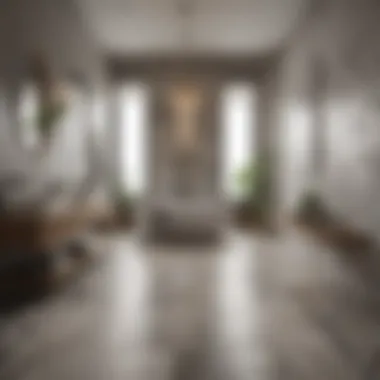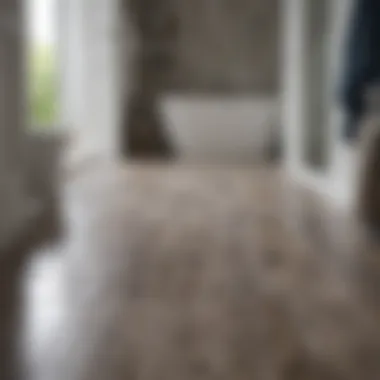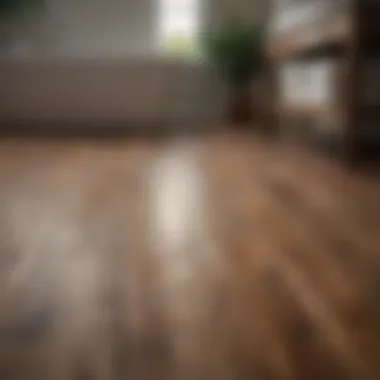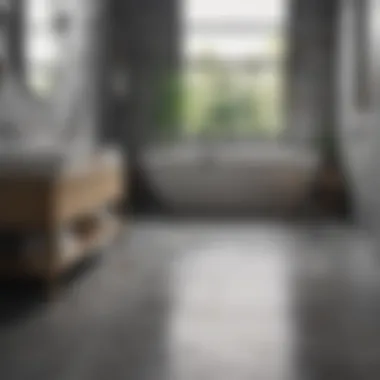Choosing the Best Bathroom Flooring Options


Intro
Choosing the right flooring for a bathroom isn't just about picking a pretty surface; it requires a bit more thought. Bathrooms see a lot of action, with moisture, spills, and foot traffic being the order of the day. For homeowners and design aficionados, understanding the intricate dance of form and function in bathroom flooring elevates the entire space.
This article dives into various flooring options—from tile to vinyl to luxe planks—shedding light on each material's unique advantages and quirks. Every choice comes with its own set of maintenance requirements, aesthetic attributes, and durability factors, making it crucial to weigh the pros and cons carefully. Moreover, as we navigate through modern trends, maintaining a balance between environmental considerations and practical utility is more important than ever.
So, whether you're a homeowner looking to refresh your bathroom or an interior design enthusiast wanting to stay in the know, this guide will help you sift through the myriad of choices available today. Let’s delve deeper into what makes each flooring type suitable for a demanding bathroom environment.
Design Inspiration
Current Trends in Interior Design
The world of interior design is constantly evolving, and when it comes to flooring in bathrooms, trends can cycle quickly. Right now, there’s a noticeable shift towards natural materials like wood and stone, reflecting a desire for organic vibes. People seem to favor earthy tones and textures, combining them with minimalistic design elements to make spaces feel airy and inviting.
For instance, light oak wood planks, which are often treated to withstand moisture, pair beautifully with soft greys or muted greens. On the other hand, porcelain tiles that mimic real stone can create a rustic, yet polished look while retaining all the benefits of modern materials, such as ease of maintenance.
Color Schemes and Palette Ideas
Selecting a color scheme for your bathroom floor can radically alter how the room feels. A crisp white or soft beige can imbue a sense of serenity, while more vibrant colors, like teal or deep plum, can add a pop of personality—ideal for those who enjoy a bold statement.
Here are some ideas to consider:
- Neutral Tones: Mix whites, greys, and tans to create a cohesive, soothing atmosphere. Perfect for a spa-like retreat.
- Bold Colors: Rich blues or greens can serve as a striking backdrop against lighter cabinetry and fixtures.
- Patterned Tiles: Customized designs in smaller spaces can give a bathroom a unique, stylish edge without overwhelming it.
"Choosing the right color can transform your bathroom from ordinary to extraordinary."
Balancing color with texture is equally vital. Consider incorporating rugs or mats in contrasting textures to define spaces within the bathroom, enhancing the overall visual appeal.
With the understanding of these design elements, we can now transition into the specifics of flooring material selection, addressing durability, maintenance, and other practical aspects essential for bathroom flooring.
Prologue to Bathroom Flooring
When it comes to home improvement, the bathroom often gets overlooked. Yet, it's one of the most used spaces, demanding attention, especially when considering the flooring options. The flooring in a bathroom is not just for aesthetics; it plays a central role in functionality, safety, and maintenance. An informed choice can lead to a space that looks good and stands up to the rigors of everyday use.
Importance of Choosing the Right Flooring
Choosing the right flooring for your bathroom may seem like a straightforward task, but it carries substantial importance. Flooring can impact everything from appearance to comfort and safety. For instance, some materials might look stunning but prove to be slippery when wet, posing a risk to family and guests alike. On the flip side, some materials prioritize durability but may not come off as welcoming or warm.
The flooring also serves as a foundational element of design. It sets the tone for the entire room, from those kick-back moments after a long day to lively gatherings with friends. Remember, this is a space where people often seek comfort and relaxation. Thus, making a choice that balances beauty with practicality is paramount.
In practical terms, an often-overlooked aspect of flooring is its maintenance. Bathrooms are subject to unique conditions, including moisture levels and temperature fluctuations. Some options require more upkeep than others, which can quickly add up in terms of time and cost. Therefore, keeping both initial investment and long-term maintenance in mind is crucial when making your decision.
Unique Challenges of Bathroom Spaces
Bathroom spaces present unique challenges that differentiate them from other areas in the home. The primary concern is moisture. Showers, sinks, and baths create an environment where water is constantly present, which means that not all materials withstand such conditions. For example, wood may warp or swell over time, while certain tiles may become loose or crack.
Additionally, spaces are often compact, meaning every inch counts. A bathroom floor needs to accommodate not only beauty but also how well it can handle foot traffic, water exposure, and even temperature changes.


Here are aspects to keep in mind:
- Moisture Resistance: Flooring must resist warping, mildew, and mold growth.
- Slippage: Bathrooms need surfaces that provide traction, especially when wet.
- Size Considerations: Smaller spaces may benefit from lighter colors to create an illusion of space, while larger areas can accommodate bolder designs.
"In choosing your bathroom flooring, consider it as if you're choosing the foundation of an enduring relationship - it needs to be strong, reliable, and appealing for the long run."
In summary, the intricacies of choosing bathroom flooring go beyond mere style. They reflect values of safety, harmony with surrounding elements, and the integral role that flooring plays in the functionality of the space. This article aims to explore these aspects, taking a closer look at various materials, their pros and cons, and how they fit into the ever-evolving design landscape.
Key Factors to Consider
When it comes to selecting flooring options for bathrooms, it's not just about aesthetics or cost; several factors come into play that can influence the longevity, usability, and overall vibe of your space. Whether you’re sprucing up an old bathroom or planning to build a new one, understanding these elements is crucial. You need flooring that withstands water, handles foot traffic, and looks good while doing it. Let's delve into the key considerations that any savvy homeowner should keep in mind.
Moisture Resistance
Moisture is the Achilles' heel of any bathroom flooring. The water splashes from the sink, moisture from the shower, and humidity levels can wreak havoc if the flooring material is not up to snuff. That’s why choosing materials with high moisture resistance is paramount.
Tile — particularly porcelain — stands tall in this regard, as its non-porous nature keeps water at bay, making it a popular choice. On the other hand, vinyl flooring also shows impressive resistance to moisture, making it suitable for those looking for a balance between style and durability. Wood—while visually appealing—may lead to regrets after a few leaks. Over time, it can swell, warp, and rot, rendering it a less-than-ideal option in these wet conditions.
"Moisture can be a stealthy intruder, but with the right flooring, you can keep it at bay."
Durability and Longevity
Next on the list is the durability and longevity of your flooring choice. Bathrooms harbor daily wear and tear from foot traffic, the occasional dropped item, and cleaning products used in maintenance. Choosing materials that can stand the test of time without cracking or fading is vital.
Ceramic and porcelain tiles are celebrated for their remarkable durability. They resist scratches and dents, ensuring that they stay looking fresh for years. Higher-end vinyl options also promise durability while offering a soft underfoot experience. In contrast, laminate flooring might initially appear as a cost-effective choice, but its lifespan often pales in comparison to that of tile or luxury vinyl. Homeowners must weigh their options carefully, keeping an eye on how long they expect each material to last in a high-moisture environment.
Aesthetic Appeal
Of course, beauty's not just skin deep; in a bathroom, flooring can make or break the entire aesthetic. Your choice of material will determine how spacious, cozy, or modern the space feels.
Ceramic and porcelain tile come in an abundance of colors and patterns. They can mimic the look of natural stone or even wood, giving homeowners flexibility in design. Luxury vinyl planks have also gained traction for their stunning visuals paired with practicality. They can effortlessly emulate high-end materials without the hefty price tag. On the flip side, while laminate offers a range of styles, it often lacks the texture that the real deal presents, leaving some feeling a bit underwhelmed.
Maintenance and Cleanability
When it comes to the bathroom's upkeep, you want flooring that can stand up to the challenge without demanding too much of your time.
Tile ranks at the top when considering cleanability; a simple wipe-down usually does the trick. Vinyl flooring also shines in this category, as it resists stains and can be cleaned with various products. In contrast, natural stone, while beautiful, requires more careful maintenance, usually needing special cleaners and sealants to fend off stains and moisture penetration. Laminate, while relatively low-maintenance, can suffer from moisture damage if not wiped up immediately, which can pose challenges in the event of spills or leaks.
Budget Considerations
Last but certainly not least, we have budget considerations. Home renovation can quickly go from a fun project to a financial headache if not managed properly. Pricing can vary significantly from one material to another.
Porcelain and ceramic tiles might pinch the wallet at the outset but return value in longevity, reducing the need for future replacements. Vinyl, especially the peel-and-stick variety, offers a budget-friendly alternative while providing the benefits of moisture resistance and decent durability. Meanwhile, natural stone tends to carry a heavy price tag both in material and installation costs. It’s essential to weigh not just the upfront costs, but also the long-term value and maintenance expenses that come with each choice.
In summary, think of these key factors as a roadmap guiding you through the maze of flooring choices. With an understanding of moisture resistance, durability and longevity, aesthetic appeal, maintenance, and budget considerations, you’re better equipped to make a smart, informed decision that suits your bathroom needs.
Exploring Various Flooring Materials
Selecting the right flooring material is pivotal when planning a bathroom remodel. Various materials not only offer different aesthetics but also vary significantly in durability, cost, and maintenance requirements. Homeowners and designers have a plethora of options ranging from traditional ceramic tiles to modern luxury vinyl planks. Each material brings its own set of advantages and drawbacks, making it vital to thoroughly understand the landscape of choices available.


Ceramic and porcelain tiles stand out for their resilience and classic appearance. Vinyl flooring, on the other hand, captures attention for its affordability and diverse designs. Natural stone exudes luxury but often comes with a price; meanwhile, luxury vinyl plank (LVP) provides a middle ground with its stylish finishes. Finally, laminate flooring, while often considered for its cost-effectiveness, raises the question of durability in moisture-prone bathroom environments. We will examine each of these materials more closely to appreciate their unique offerings and challenges.
Ceramic and Porcelain Tile
Benefits of Tile
Ceramic and porcelain tiles are often the go-to choice for bathrooms due to their impressive moisture resistance. This key characteristic allows them to hold up well in environments where water exposure is a given. Moreover, the aesthetics of tile cannot be overlooked; they come in a wide range of colors, sizes, and patterns, providing endless possibilities for customization. In addition, the durability of these tiles ensures a long-lasting finish in your bathroom, making them a popular choice.
- Durability: Resistant to wear and tear.
- Low Maintenance: Easy to clean and maintain.
In terms of disadvantages, you might encounter issues like
Environmental Considerations
Understanding the environmental impact of flooring choices is more crucial than ever, given our planet's escalating issues like climate change and resource depletion. Homeowners now prioritize sustainable practices, and this mindset reflects directly in bathroom renovations as much as in any other part of the home. Choosing suitable materials isn't just about aesthetics or maintenance; it’s also about making choices that favor the environment. For instance, the flooring you install can either contribute to a significant waste problem or promote healthier living spaces. This segment of the article showcases sustainability and green certifications, essential concepts for making informed decisions.
Sustainability of Materials
When discussing sustainability regarding bathroom flooring, it’s vital to look at the lifecycle of materials. There’s more to it than just what goes into your bathroom; it involves how materials are sourced, manufactured, and eventually disposed of. A good choice for sustainable materials might be bamboo or cork, as they grow quickly and can be harvested responsibly without causing extensive ecological disruption.
On the flip side, some materials like laminate might appear appealing due to lower costs, but they could contain harmful chemicals and require far more energy to produce. These materials often end up in landfills when they reach the end of their life. Homeowners should get familiar with how long each flooring type lasts and what happens to it after it’s no longer usable. Choosing sustainable options means opting for longer-lasting materials that don’t require frequent replacement, therefore reducing waste.
In addition, some manufacturers are jumping on the eco-bandwagon by developing flooring made from recycled content. These materials help reduce reliance on virgin resources and lower overall environmental impact. It’s worth taking a moment to ask how a flooring option contributes back to maintaining our environment.
Green Certifications and Ratings
With increasing demand for environmentally friendly products, various certification programs have emerged, helping consumers navigate their choices. Recognizing the labels ensures that you’re not just taking a manufacturer’s word for it. Programs like FloorScore and the Forest Stewardship Council (FSC) provide insights into a product’s emission levels and sustainability practices. For example, materials certified by the FSC assure homeowners that the wood used has been sourced from responsibly managed forests,
It’s not just about having the right label; it's understanding what these certifications signify. Some variations may include air quality standards, energy-efficient production, and even commitments to minimize the use of harmful chemicals. Here are a few certifications worth noting:
- LEED (Leadership in Energy and Environmental Design): Highlights buildings and products that meet specific green building criteria.
- Cradle to Cradle: This rating assesses a product’s safety and sustainability, concerning its lifecycle.
- SCS Global Services: Offers product certifications across various categories, including sustainable flooring.
"By investing in certified flooring options, you not only enhance your bathroom's appeal but also contribute to a healthier planet."
As a savvy homeowner or design enthusiast, you should do your homework on these certifications before making a purchase. Understanding the environmental impact of your choices leads to more informed decisions and helps shape a healthier ecosystem.
Trends in Bathroom Flooring
As homeowners become increasingly invested in interior aesthetics and functionality, the trends in bathroom flooring have shifted dramatically. It’s more than just choosing a surface to stand on; it’s about setting the scene for relaxation and style, while also ensuring durability against the challenges presented by moisture-rich environments. In this ever-evolving landscape, understanding the latest trends can guide you in making informed choices that merge practicality with modern design.
Current Aesthetic Trends
Today’s bathrooms are taking a cue from more luxurious spaces. Homeowners are gravitating towards soft, neutral palettes infused with rich textures.
Some notable aesthetic trends include:
- Geometric Patterns: Bold abstract designs and intricate tile arrangements are making waves. These can add an artistic flair and personality to what might otherwise be considered a utilitarian space.
- Natural Inspired Designs: Wood-look tiles or stone textures lend an organic feel to bathrooms. They make one feel close to nature, creating a serene escape. For instance, porcelain tiles that mimic the grain of oak provide warmth without the associated maintenance of real wood—an important consideration in a moist environment.
- Spa-Like Spaces: There’s a growing tendency to create bathrooms that evoke a spa vibe. This usually involves a careful balance of calming colors, elegant fixtures, and high-quality materials that convey a sense of relaxation.
- Sustainability: Reflecting a broader societal shift, many are looking for eco-friendly options like recycled tiles and sustainably sourced materials. This not only benefits the planet but can also add a unique touch that resonates with a modern audience.


Aesthetics in bathroom flooring are no longer an afterthought; they’re central to how the entire space is perceived.
Emerging Technologies in Flooring
The world of flooring technology is advancing at a rapid pace, with innovations that not only enhance the aesthetic appeal but also improve functionality. Here are several key trends emerging in flooring technologies:
- Waterproof Technologies: Modern vinyl and laminate products now come equipped with advanced waterproofing measures that safeguard against leaks and spills. Luxurious vinyl planks, for instance, often employ detailed construction techniques allowing them to withstand high humidity levels without warping or losing integrity.
- 3D Printing: While still gaining traction, 3D printing offers a tantalizing prospect in creating bespoke flooring options that cater to individual tastes. Homeowners could one day select patterns or designs that are uniquely theirs, crafted to fit their specific bathroom dimensions perfectly.
- Smart Flooring Solutions: Incorporating technology, such as heated flooring systems, is becoming popular. These not only provide a touch of luxury but also enhance comfort in cold months.
- Eco-Friendly Innovations: Many manufacturers are now utilizing biodegradable materials and low-VOC finishes which decrease environmental impact while making design choices healthier for the inhabitants.
To summarize, staying updated with trends in bathroom flooring is crucial for creating a space that not only serves its purpose but also embodies the homeowner's personality and values. The trends illustrate a blend of comfort, design creativity, and smart technology that pave the way for more personalized and functional bathroom environments.
"A bathroom is no longer a place for mere cleansing; it's becoming a canvas where innovation and style harmonize."
Whether you are planning a renovation or simply aiming to refresh your space, embracing current trends can lead to exciting possibilities.
The Installation Process
When it comes to bathroom flooring, selecting the right material is only half the battle. The installation process is pivotal in ensuring that the flooring not only looks great but also functions well over time. If the tiles aren't laid properly, or if the vinyl isn't adhered correctly, you could find yourself facing costly repairs down the line. This section will delve into the various facets of the installation process, addressing preparation steps, hiring professionals, and tips for those who might tackle a DIY job.
Preparation Steps
Before getting your hands dirty, proper preparation is key. Think of it as laying the groundwork—quite literally. Here’s what to keep in mind:
- Assess the Subfloor: Check if the subfloor is in good condition. Cracks, moisture, or unevenness can cause your new flooring to warp or buckle.
- Gather Tools and Materials: Depending on the type of flooring being installed, gather the necessary tools such as tile cutters, utility knives, and measuring tapes. Make sure to have all materials on hand before starting the process to avoid any unexpected trips to the store.
- Measure Twice, Cut Once: This old saying remains relevant in flooring. Take multiple measurements of the space to ensure your cuts are precise.
- Acclimatize the Materials: Let your tiles or planks sit in the bathroom for 48 hours prior to installation. This allows for any expansion due to humidity or temperature changes, ensuring a snug fit later.
Taking these preliminary steps may appear tedious, but they can save you from headaches in the long run. A well-prepared location paves the way for a smoother installation process.
Choosing a Professional Installer
Hiring a professional can significantly lessen the worry, especially if you're unsure about the intricacies involved in flooring installation. Here are some points to consider:
- Experience Matters: Look for installers who have considerable experience, especially with the specific materials you have chosen. Tile and vinyl are two very different beasts in terms of installation.
- Reviews and Recommendations: Seek out reviews in local listings, or ask friends and family for referrals. A trustworthy installer often comes recommended by someone who has had a great experience.
- Get Multiple Quotes: Don’t settle for the first quote you receive. Gather a handful of estimates and understand what each covers. This helps in ensuring you're not being overcharged for the service.
- Check Credentials: Always inquire if the installer is licensed and insured. This protects you from liability if something goes south during the installation.
The right professional can offer insights that save you time and money in the long haul, providing confidence that your bathroom floor will withstand the test of time.
DIY Installation Tips
For those who possess a knack for handiwork, taking the DIY route can be both rewarding and cost-effective. Consider the following tips before you dive in:
- Follow Manufacturer Instructions: Each flooring type comes with specific guidelines. Make sure to read these thoroughly to avoid common pitfalls.
- Taking Breaks: It might seem more productive to charge through the work, but taking breaks can prevent you from making careless mistakes due to fatigue.
- Use Leveling Tools: Ensure everything is even. An uneven surface can lead to cracks and wear sooner than anticipated.
- Have a Helper: Whether it's to hold things steady or assist with measuring, having an extra pair of hands can be invaluable.
Remember, patience is a virtue in DIY projects. Rushing might be tempting, but taking your time often yields the best results.
"A good foundation is a key to lasting beauty in your home. Prepare well, and everything else will follow."
As you navigate through the installation process, keeping these tips in mind will help facilitate a seamless transition to your new flooring, ensuring that your bathroom looks as good as it functions. With meticulous planning, and perhaps a little caution, your flooring investments can truly shine.
Finale
In summing up the extensive exploration into flooring options for bathrooms, it’s clear that the right choice holds more weight than mere aesthetics. The bathroom is a unique environment where moisture and foot traffic can wreak havoc on subpar materials. Therefore, making a well-informed decision about flooring is crucial, not only for looking good but also for ensuring longevity and functionality.
Recap of Key Points
- Moisture Resistance: With excess humidity being the bane of any bathroom, prioritizing materials that repel water is paramount. Tiles and luxury vinyl plank options shine in this regard, offering resistance to both moisture and stains.
- Durability: Bathrooms often endure heavy use, so flooring must withstand years of wear and tear without succumbing to scratches or dents. Ceramic and porcelain tiles excel in durability, providing a solid foundation.
- Aesthetic Appeal: Choosing a flooring material that complements your bathroom’s design can enhance the overall ambiance. Natural stone can lend an air of sophistication, while vinyl flooring opens up a world of creative designs.
- Maintenance and Cleanability: The last thing anyone wants is to spend hours cleaning dried fingerprints off their flooring. Materials like vinyl are easy to maintain, while others like stone need ongoing upkeep to preserve their shine.
- Budget Considerations: Flooring can sharply vary in price, so keeping the budget in check is vital. Vinyl flooring provides a cost-effective alternative without sacrificing style, while natural stone may entail higher installation costs.
In light of these factors, it is evident that homeowners, interior design enthusiasts, and even those who simply enjoy hosting gatherings need to consider both form and function when choosing bathroom flooring. The right selection not only enhances aesthetic pleasure but also ensures practicality. It's important to weigh each option carefully against individual lifestyle needs and aesthetic preferences, ensuring a choice that feels just right for the unique environment of the bathroom.



